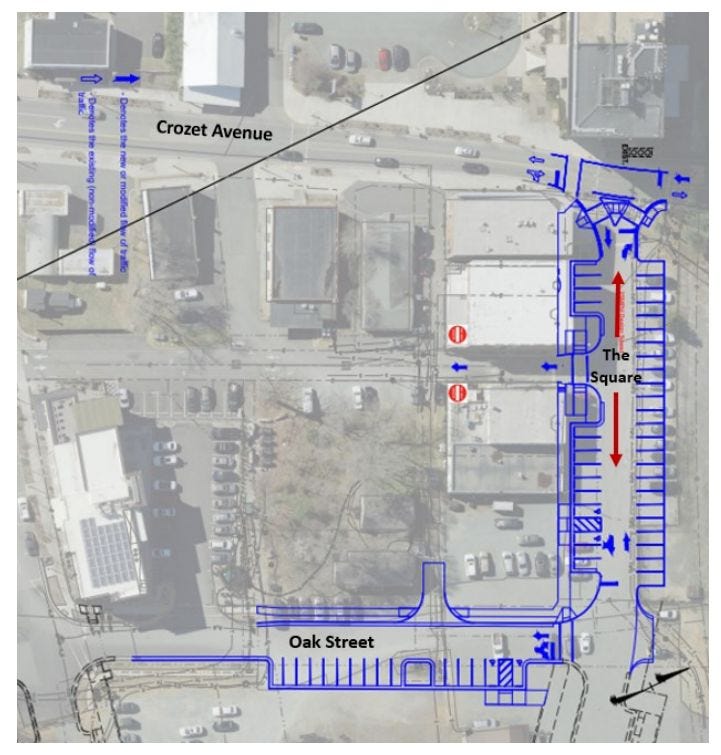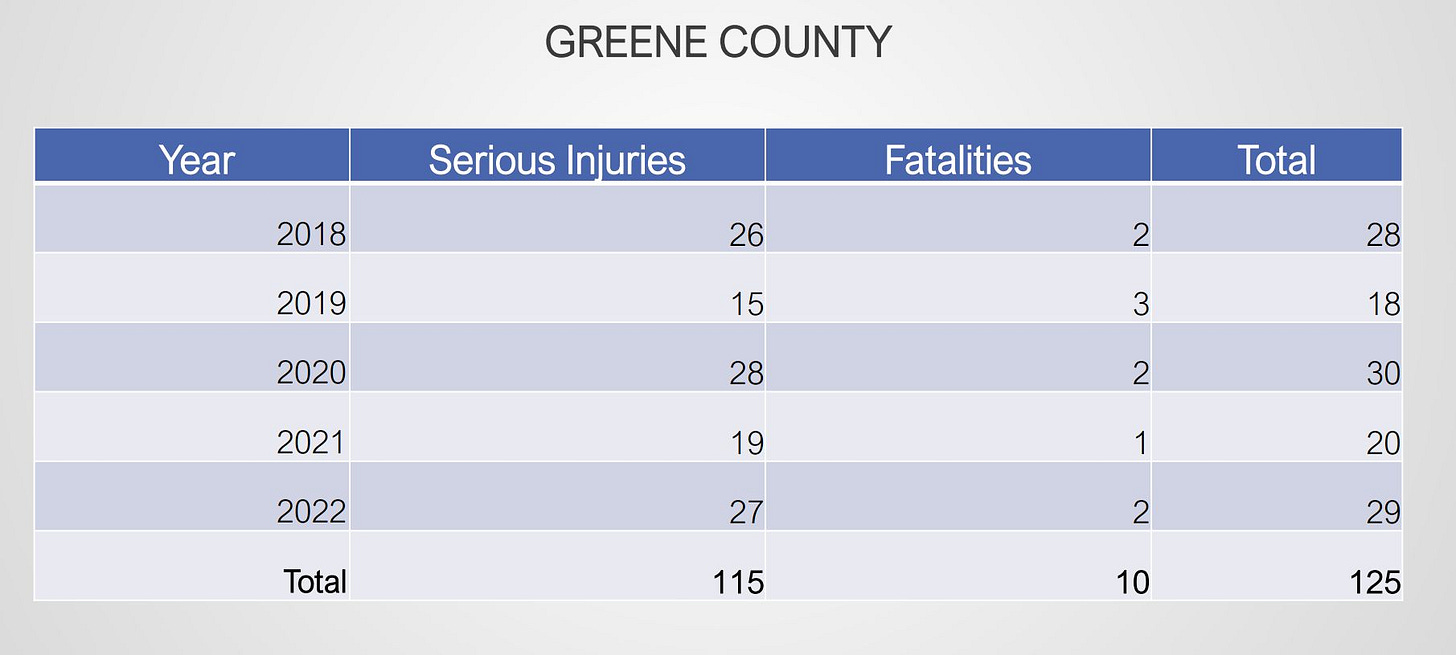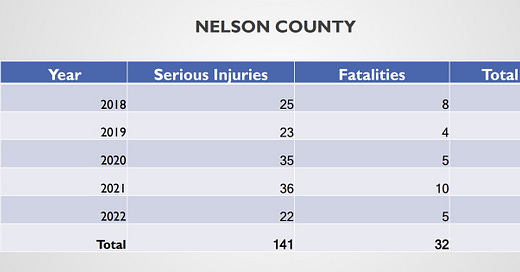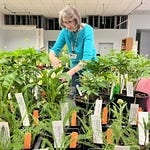According to data collected by the website eBird and curated by the American Bird Conservancy, there are at least 488 species of our feathered friends in Virginia. Every edition of Charlottesville Community Engagement, including this February 20, 2024 edition, is fueled by observations of the activities of winged creatures who are unaware of the existence of journalism. I’m Sean Tubbs, and perhaps there’s grant funding available to attempt translations to penetrate an untapped market?
On today’s show:
Work could start this summer on new infrastructure at The Square in Crozet
A project to create a safety plan for area roads in the region goes before the Greene and Nelson Boards of Supervisors
Charlottesville City Council has another discussion about the FY25 budget and learns more about a process driven by their priorities to retain staff and implement collective bargaining
First shout-out: ReLeaf Cville
In today’s first subscriber supported public service announcement: ReLeaf Cville exists to reverse a worrying trend. Since 2004, Charlottesville’s Tree Canopy has declined from 50 percent to 38 percent. Two-thirds of the city’s neighborhoods are below 40 percent. ReLeaf Cville aims to change that through a series of tree plantings, preservation efforts, and education campaigns.
ReLeaf is a public / private partnership between the city tree Commission, the Nature Conservancy, City of Promise, Charlottesville Area Tree Stewards, and the Van Yahres Tree Company. Their efforts are funded through donations so consider making yours today!
Albemarle report provides details into Crozet’s Square project
In June 2012, Albemarle County acquired a 0.36 acre parcel in downtown Crozet from CSX Transportation in a transaction in which no money changed hands. The strip of land is known as The Square and spans between Crozet Avenue and Oak Street on the western edge of the Barnes Lumberyard.
Nearly 14 years later, the county’s Facilities and Environmental Services Department (FES) reports that a project to improve the space is close to a development milestone.
“This Revenue Sharing project with VDOT will improve [Americans with Disabilities Act] accessibility to local businesses by adding additional ADA parking and 8 additional ramps,” reads the top story in the latest report from FES. “The County will also be widening and smoothing uneven sidewalks to make this a safer place for all.”
The project has a total cost estimate of $1.5 million according to a dashboard that is part of the Virginia Department of Transportation’s six-year improvement program. The cost is evenly split between Albemarle County and VDOT as this is a revenue-sharing program.
The work will also prohibit left turns from the Square onto Crozet Avenue and an entrance to property that is now owned by the Virginia Passenger Rail Authority will be relocated. VPRA purchased the property from CSX as part of former Governor Ralph Northam’s passenger rail initiative.
According to the FES report, this work was to have happened concurrently with the redevelopment of the Barnes Lumberyard but the latter has not yet progressed to the design phase.
“The financial benefits associated with combining the projects have been negated, so the project is scheduled to be ready for bid advertisement in April 2024 with construction anticipated to begin in late summer,” the report continues.
Construction is expected to take roughly a year.

Nelson, Greene Supervisors briefed on Move Safely Blue Ridge initiative
Local elected officials around the Charlottesville region are in the process of endorsing work that the Thomas Jefferson Planning District is currently doing to help draw down more federal money for transportation safety projects.
The TJPDC secured a $857,600 grant from the U.S. Department of Transportation to create what’s known as a “comprehensive safety action” plan for its six member localities. This is a prerequisite for receiving funding from the 2021 Bipartisan Infrastructure Law and specifically a program called Safe Streets For All. One person working on the project appeared before the Nelson County Board of Supervisors on February 13, 2024.
“By developing this comprehensive safety action plan, we are going to render Nelson County and the region more broadly eligible for funding for implementations through SS4A, so this opens up a new pot of money potentially for projects in the future,” said Curtis Scarpignato, a planner with the Thomas Jefferson Planning District Commission.
Scarpignato said the TJPDC will work closely with Nelson County staff to develop a local plan listing projects that could help reduce crashes. The TJPDC will also help with grant compliance. For it all to work, the TJPDC needs resolutions of support from all of the member localities.
“From 2018 to 2022, there were 173 such serious injuries or fatalities on the roads in Nelson County,” Scarpignato said. “And the commitment must include a goal and timeline for eliminating those roadway fatalities and serious injuries which may be accomplished through an ambitious percentage reduction goal.”
Supervisor Jesse Rutherford noted the 32 fatalities listed in the slide presentation for that five-year period.
“I’d be interested to see where those fatalities were located in our community,” Rutherford said.
That information can be found on the Virginia Department of Transportation’s safety dashboard. You can get information on any locality on the interactive website. Take a look!
Supervisors endorsed the resolution to set the goal of reducing those fatalities in half by 2045.

A few hours later, Scarpignato and other TJPDC staff traveled the 54 miles from Lovingston to Stanardsville to make a presentation to the Greene County Board of Supervisors and to secure their support.
“So between 2018 and 2022, there were 125 deaths and serious injuries on the roads in Greene County,” Scarpignato said.
That breaks down as 10 fatalities and 115 serious injuries.
Supervisor Davis Lamb wanted a further breakdown.
“Are those fatalities that you have,” Lamb said. “Are some of those pedestrians? I know next to the corner store at Route 607 they’ve had some fatalities but they were pedestrians crossing the road.”
A check of VDOT’s crash database shows two pedestrian fatalities in Greene in 2018 including one on U.S. 29 just south of Route 607 . There was another one at Route 607 in 2019, but there were no pedestrian deaths in the next three years. There was one pedestrian fatality on U.S. 33 business in Stanardsville in 2023.
Another member of the Board was skeptical that the reduction goal as stated was realistic.
“I mean, you say you’re going to decrease the death rate by 2045 by 50 percent,” said Francis McGuigan. “So you’re going to reduce that number to one fatality and 12 serious injuries even though we’re looking at a population growth of at least 35 to 40 percent.”
McGuigan suggested it would be more honest to state the reduction target as part of a per capita basis.
“I don’t think there’s anyway no matter what you did unless you turned off every vehicle there was that you would actually get anywhere near what you’re talking about,” McGuigan said.
Scarpignato said the county could use different metrics if they wanted, but the choice was made to replicate what the Virginia Department of Transportation is using.
“The way I would think of this goal is more about committing to the action of trying to resolve the roadway safety issues on the roadways,” Scarpignato said. “It’s not going to be about the exact number we pick.”
Supervisor Lamb expressed a concern about bike lanes being close to the roadway. He would like more protection.
“These bicycle paths they have right on the edge of the road and they have a line and they have a rider painted on there and all,” Lamb said. “I’d rather have just a small strip of grass and then a walkway with a bicycle path because I know it may cost extra but people are a whole lot safer.”
Scarpignato said the comprehensive safety plan action would address safety for all users of roadways. Lamb had one more comment.
“Everybody talks about walkability and something like that and walk to the store,” Lamb said. “You might do that in Los Angeles but you can’t do it here!”
Supervisors endorsed the resolution. Scarpignato said the Board should expect a report with recommendations in about a year and a half.
Fluvanna Supervisors had the same presentation on February 7. The Louisa County Board of Supervisors will learn more this evening. Will their comments be enshrined in an edition of Charlottesville Community Engagement? Stay tuned.

Second shout-out: Plant Virginia Natives
More light each day indicates a gradual move toward spring and the time when the world around us will come to live with a new season. Now is the time to plan for what you might grow to take advantage of whatever space you may have to extend a little habitat. That’s where Plant Virginia Natives comes in!
The initiative is part of a partnership with ten regional campaigns for ten different ecosystems across Virginia, from the Northern Piedmont to the Eastern Shore. Take a look at the full map below for the campaign for native species where you are in the Commonwealth. For the Charlottesville area, download a free copy of the handbook: Piedmont Native Plants: A Guide for Landscapes and Gardens. As I plan for spring, I’m going to take a look because after almost four years of one Patreon supporter selecting this as his shout-out, I’m excited to get to work myself!
Council further discusses FY25 budget during discussion of FY23 surplus
In 14 days, Charlottesville City Manager Sam Sanders will unveil his recommended budget for fiscal year 2025, a budget that will be built on this year’s property assessments as well as a need to spend money to retain existing city staff.
Council provided direction at a work session on February 1 and at that time, Sanders said he was working to close a gap between $3 million and $4 million. (read my story)
A few days later, Council discussed the budget again during second reading of an appropriation of a surplus from the FY 23 budget of over $21.7 million. No had spoken at a January 22 public hearing based on a recommendation from Sanders on how to allocate the funding. (read my story)
The second reading of the resolution to appropriate the surplus had been on the consent agenda for the February 5 meeting, but was pulled by City Councilor Brian Pinkston who had a different idea on how to use some of the funding.
“So when this first came to us two weeks ago that was before at least I knew the sort of impact of this current budget, the FY25 budget, that we’re working through,” Pinkston said.
At that work session, a majority of Council supported the possibility of raising tax rates to close the gap in order to pay staff more money by implementing the terms of a compensation study as well as honoring collective bargaining agreements with three distinct units. Sanders has suggested doing all of that in a single year.
“I realize that trying to do that over multiple years makes no sense but for those same reasons I think that trying to cover this ongoing expense immediately with tax increases only is not fair to the people in Charlottesville,” Pinkston said.
Pinkston suggested using some of the surplus on covering the personnel costs and pointed out that $15.82 million designated for the capital improvement plan contingency fund was more than enough. He also supports tax rate increases but said using surplus funds would help soften the blow.
City Councilor Lloyd Snook had floated the idea of a four cent increase on the real property tax rate, but began to reconsider.
“I went back and looked and the first thing that came to my mind was how are we going to sell it to the citizens of Charlottesville that we have a $21 million surplus and we want to raise your taxes for $4 million,” Snook said. “That doesn’t make sense.”
Snook said the city is already using that surplus for ongoing expenses, such as $2.6 million to fund a two percent cost of living increase for retired city employees. Budget director Krisy Hammil confirmed that is a one-time use of funds. COLA is a commonly used acronym to describe “cost of living allowance.”
“Last year the city granted a six percent COLA employees and retirees got three so there was a two percent COLA for retirees that was unfunded payment to make up for that and then going forward, that’s covered, but it’s a one-time actuarial payment to reduce the liability that was created for the unfunded two percent payment,” Hammill said.
The semantics of “one-time” use were applied to other line items such as whether a $400,000 line item to cover the cost of an off-budget increase in the city’s trash-hauling contract price was a recurring expense or not. Snook also questioned a $200,000 line item to go to a fund to pay for maintenance of properties the city leases to others.
“We’re not talking about City Hall or the annex,” Hammill said. “We’re talking about properties that have been acquired like 0 East High Street and other things. There is not a pot of money beyond any normal maintenance to cover a recurring maintenance that may happen with those properties. This $200,000 is intended to be a seed pot of money to help cover the maintenance for those properties and the idea is the rent from those properties will go into an account so we can have the funding to cover that maintenance.”
City Councilor Michael Payne said he supported staff’s recommendation as is, and said the funding in the capital improvement program could be used for this purpose in the future.
City Manager Sanders said a good portion of the surplus was created by vacant positions that were funded but not filled. He also said he will need the entire $15.8 million in the CIP contingency fund.
“So when you received your budget preview last week, we did not spend any time talking about the surplus because it’s one-time money and the intention is to use as much of it for one-time expenses related to those two priorities that this body adopted as its priorities,” Sanders said.
Sanders said the money in the CIP contingency fund would not be tied to any project at this time but would instead be kept in reserve simply to balance the FY23 books. He said Council’s previous allocations from the fund allowed for the $5 million purchase of a half-share of 74 affordable units, the $5.4 million acquisition of the Charlottesville Area Technical Education Center, and other big-ticket items. Similar large capital items are looming.
“If we tie this now to the implementation of collective bargaining and [compensation and classification], you have fully restricted yourself from even having those options and we all know that you have decisions still coming,” Sanders said. “Alternatives fuels for [CAT] buses. You’re probably going to have an another affordable housing project that is not in the five year [capital improvement program] plan that we’re bringing to you as well as a whole host of other things.”
Sanders said there are three additional collective bargaining units coming to Council in the future, and that’s going to increase costs even further.
The resolution to adopt the allocation of the FY23 surplus passed unanimously.
The conversation took place before a work session with the School Board on February 7, another item I’ve not had a chance to go through yet.
Confused? It’s natural. Municipal budgeting is not a straightforward thing to understand. There is also much less substantive journalistic coverage of these sorts of things as they once might have been, and I’m hoping that changes. I write about this stuff because I want to understand. I ask questions to try to get there.
#638 concludes at the end of the sponsor acknowledgement
With this edition I conclude coverage of the February 5, 2024 meeting of Charlottesville City Council. I don’t believe there are other accounts, and I don’t say that to brag. I say that with lament because municipal governance is complicated and it is very easy to take things out of context. I view my role as one that seeks to provide information and not to pass judgment.
Every edition of this newsletter is intended to educate and inform, and at some point I am hoping to train people who would be interested in learning. Do you know someone who would like to learn some basic skills in reporting and production? In the weeks to come, I will be launching a new partnership project and to pull it off, I’m looking for volunteers with the potential for payment quite possible in the future. Drop me a line!
Of course, I have to end this edition by reminding you that Ting will match your initial Substack payment because Ting supports community journalism. Thank you Ting!
And maybe you’re in the market for new Internet? Check out Ting to see what they have to offer, and if you decide to proceed, enter in the promo code COMMUNITY to receive:
Free installation
A second month for free
A $75 gift card to the Downtown Mall


















Share this post